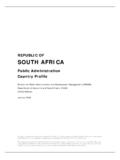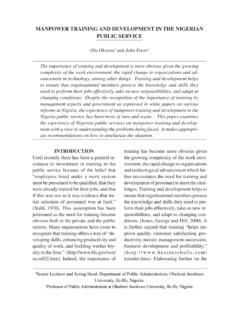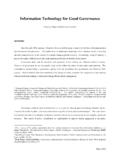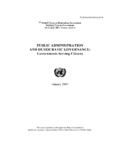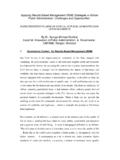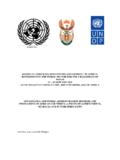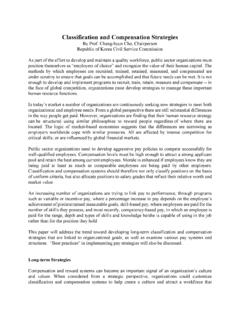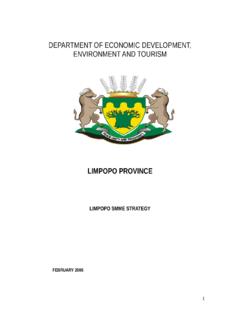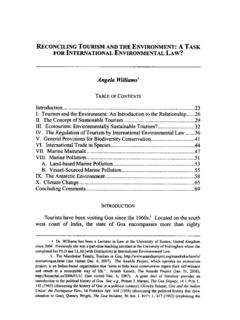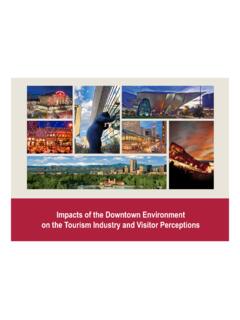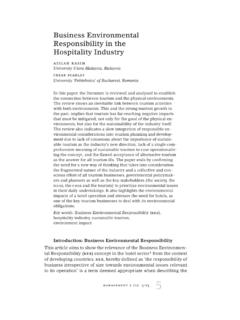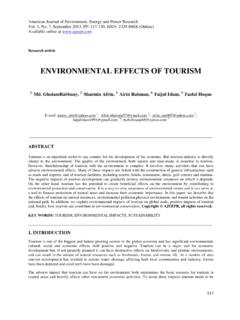Transcription of MINISTRY OF ENVIRONMENT AND TOURISM - United Nations
1 MINISTRY OF ENVIRONMENT AND TOURISM Background Etosha Centenary 1 Celebrating 100 years of formal conservation Etosha - great white place The Etosha National Park Centenary Celebrations February 2007 Introduction Etosha National Park or the great white place is Namibia s flagship national park. Proclaimed in 1907 in a bid to stop uncontrolled hunting, the park boundaries remained unchanged until 1958. Further reductions in size meant that Etosha now measures about one fifth of the original size, but Etosha National Park is still one of the largest and most important protected areas in the world. Stretching more than 350 km from east to west and covering an area of 22 270 square kilometres, the park has 114 mammal species - several of which are rare and endangered - 380 bird species, 110 reptile species, 16 amphibians and one fish species.
2 It also has 16 main vegetation zones, and is the only place where dwarf saline shrub savanna vegetation is found in Namibia. A remarkable development over the past 10 years has been the establishment of communal area conservancies in Kunene Region, which roughly lie within the old Etosha boundaries. These have helped restore vital wildlife corridors between Etosha and the Skeleton Coast Park. Wildlife populations in this zone have strongly recovered due to the commitment of local communities and Namibia s incentive-based Community-based Natural Resource Management (CBNRM) Programme. Similar changes are anticipated in other areas neighbouring the Etosha National Park. Etosha is stepping into its next century of existence with a list of conservation activities and the finalisation of plans.
3 These include the recent translocation of a black rhino from the park to neighbouring Khoadi //H as Conservancy, Kunene Region, the first regional Human Wildlife Conflict Management plan with neighbouring Ehirovipuka Conservancy, an agreement by Cabinet to purchase neighbouring land for the Hai//om to create two conservancies that will be supported by Etosha, the first business plan for Etosha, a new management plan, the first road management plan for the park and the upgrading of resorts by Namibia Wildlife Resorts (NWR). This year, a breeding group of black rhino from the park will be donated to Zambia, the first fencing management plan will be finalised, the first joint venture approach with neighbouring conservancies on Etosha s fence construction and maintenance will be concluded and two new gates will soon be established at Narawandu and Oshivelo.
4 The Namib Desert Park was also proclaimed in 1907. Several changes to boundaries were made and in 1990, a section of Diamond Area 2 was added to create the current Namib-Naukluft Park (NNP), with an area of 49 798 square kilometres. Although centenary celebrations include the NNP, the focus of our efforts for the centenary celebrations will centre on Etosha. 2 100 years of Conservation Namibia is proud that some internationally threatened large mammal species, such as elephant, black and white rhino, black-faced impala and lion have been successfully conserved during 100 years of formal protection. The last elephants in the Etosha region were shot at Namutoni in 1881 while black rhino were virtually absent and white rhino were extinct in the park by the turn of the century.
5 Black-faced impalas were reduced to a few small herds near Namutoni and lions were also reportedly absent at the time of proclamation. However, the populations of these animals have been restored, with about 2 200 - 2 400 elephants currently occurring in the Park, while successful conservation measures have led to the park s black rhino population being the largest in the world. White rhinos were re-introduced in 1995 and have successfully adapted to their new ENVIRONMENT . The lion population has also recovered and is now one of the most important populations in southern Africa because it has remained free from the FIV virus that has spread through other populations. Black-faced impala, endemic to northwest Namibia, were captured in Kunene Region between 1969 and 1971.
6 They were taken to western, central and eastern Etosha and have successfully bred, enabling the MET to return animals to two conservancies in Kunene Region in 2006. Surplus animals from the park are being captured and translocated to old distribution grounds. In August 2006, giraffe were taken to eastern Caprivi, where the last animals were shot in the 1980s. Why celebrate 100 years of Etosha and the Namib? There are a number of achievements the MET and partners would like to see through the Etosha Centenary celebration: ENVIRONMENT - biodiversity TOURISM creates income opportunities, contributes to the national economy and creates jobs Opportunities for partnerships, new management plans, a new vision for conservation areas Sustainable development - as reflected in the Namibian Constitution and Vision 2030 Heritage celebrating our history and the legacy for our children Awareness the value of our protected areas 3 The significance of parks and increased TOURISM The TOURISM industry in Namibia is widely viewed as having major potential for economic growth and development, with international arrivals having grown steadily over the past decade and a half to over 600 000 in recent years.
7 With an average growth rate of some 16% per annum over this period. In 1990, only 36 246 tourists visited Etosha; while an estimated 165 000 visited the park last year. Our national parks are estimated to contribute between N$1 billion and N$2 billion to the national economy, funds that are used to bring development to Namibia, while the number of jobs created is also increasing. The significance of Etosha to neighbours Increased TOURISM to the park brings opportunities for jobs, the development of services and spin-off industries. Healthy populations of game mean that animals can and have been translocated to their previous historic distribution areas. This is important for biodiversity but also brings benefits to communities, particularly conservancies, which can venture into TOURISM or trophy-hunting activities.
8 Culturally the return of wildlife to their previous areas enables children to see species they have only heard about in stories from their elders. Living alongside a national park also has its problems, as animals such as elephants, lions and a range of predators move onto farm land. The MET is seeking to address this by introducing policies such as the Human Wildlife Conflict Policy and Parks and Neighbours Policy, while the Parks and Wildlife Management Bill is expected to be tabled in Parliament within the centenary celebration period. National and International Significance The centenary is a landmark in terms of national achievements, with new conservation efforts geared towards achieving Vision 2030.
9 Internationally, the contribution to biological diversity conservation is notable, particularly regarding the safe-keeping of charismatic species such as elephant and rhino. The pan is registered in the Ramsar Convention s List of Wetlands of International Importance. Centenary activities The partnership of MET, Namibia Wildlife Resorts (NWR), Namibia TOURISM Board (NTB) and Team Namibia will facilitate celebrations nationally and internationally. These start on 22 March 2007 and will run for the period of one year. The focus of the MET is to improve existing infrastructure in preparation for the next 100 years. A grant of N$10,5 million was received from the Game Products Trust Fund and is being used to upgrade infrastructure such as roads, firebreaks, fences, toilets, entrance gates, refuse sites and sewerage works.
10 NWR will spend about N$60 million, allocated by Cabinet earlier this year, on refurbishing accommodation at the three camps in the park. An Etosha Centenary Working Group, with representatives from partner institutions, meets regularly to plot the way ahead for the centenary celebrations. 4 Staff from all directorates of MET and NWR based in Etosha have identified their priorities for centenary celebrations and have formed a committee that will take on several local-level activities and collect information. Two Etosha Centenary coordinators have been appointed to facilitate activities. Plans are underway to: Open western Etosha for guided tours; Trial walking trails and guided night drives; Establish hides at three waterholes; Build kiosks at various points within the park, at which visitors can leave their vehicles, use ablution facilities and purchase refreshments; Establish themed information centres at each of the three rest camps (Okaukuejo, Halali and Namutoni); Review the range of products sold in camp shops, with emphasis placed on local goods; Explore the possibility of opening a gate at Narawandu on the northern boundary and at Oshivelo to the east; Reduce the current speed limit from 60 km/h to 50 km/h; Repair infrastructure such as main roads, sewerage works.
